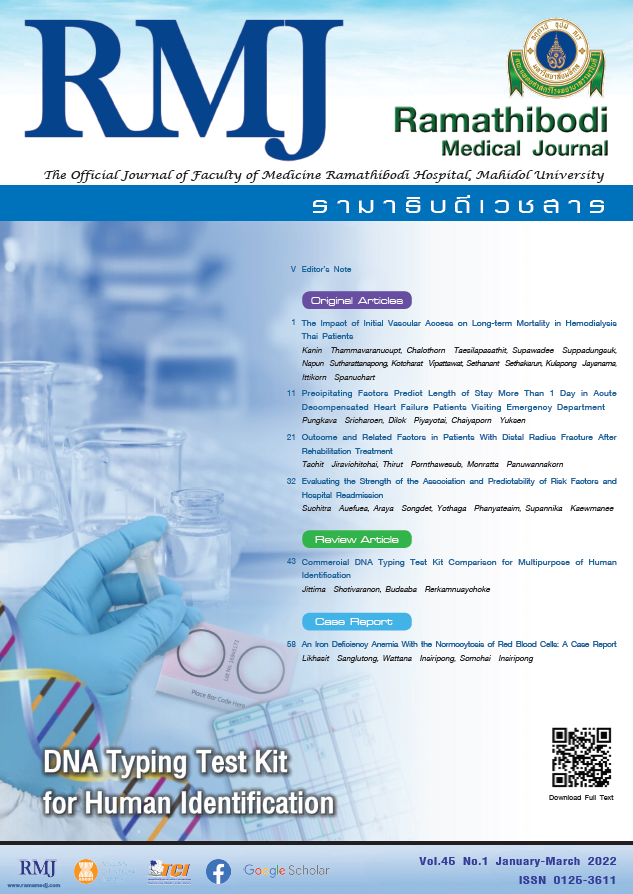Precipitating Factors Predict Length of Stay More Than 1 Day in Acute Decompensated Heart Failure Patients Visiting Emergency Department
DOI:
https://doi.org/10.33165/rmj.2022.45.1.252761Keywords:
Acute decompensated heart failure, Length of stay, Emergency roomAbstract
Background: Patients with acute decompensated heart failure have different precipitating factors. Therefore, there will be a different length of hospital stays.
Objective: To identify precipitating factors in acute decompensated heart failure patients that predict the length of stay of more than 1 day.
Methods: A retrospective cohort study collected data of acute decompensated heart failure patients who were not dead and not inserted an endotracheal tube in the first 6 hours who came to the emergency department of Ramathibodi Hospital during 2016 to 2017. Collected data from the characteristics of patients, underlying diseases, medical signs, vital signs and laboratory in the emergency department, and factors stimulating acute decompensated heart failure in patients. Logistic regressions were used for data analysis.
Results: Of all 213 patients, 151 patients stayed in the hospital for more than 1 day and 62 patients in less than 1 day. Precipitating factors that predict more than 1 day of hospital stay are arrhythmia and acute coronary syndrome. Precipitating factor that predicts less than 1 day of hospital stay is noncompliance with medications. After adjusting by sex, age, comorbid, and NYHA class, precipitating factors that predict more than 1 day of hospital stay is an arrhythmia (OR, 7.46; 95% CI, 2.09 - 26.60).
Conclusions: Patients who precipitate acute decompensated heart failure by arrhythmia have probably more than 1 day of hospital stay. In the case of hospital bed limit, this group of patients should be considered as inpatients.
References
Moleerergpoom W, Hengrussamee K, Piyayotai D, et al. Predictors of in-hospital mortality in acute decompen-sated heart failure (Thai ADHERE). J Med Assoc Thai. 2013;96(2):157-164.
Weintraub NL, Collins SP, Pang PS, et al. Acute heart failure syndromes: emergency department presentation, treatment, and disposition: current approaches and future aims: a scientific statement from the American Heart Association. Circulation. 2010;122(19):1975-1996. doi:10.1161/CIR.0b013e3181f9a223
Silvester K, Harriman P, Walley P, Burley G. Does process flow make a difference to mortality and cost? an observational study. Int J Health Care Qual Assur. 2014;27(7):616-632. doi:10.1108/ijhcqa-09-2013-0115
Martín-Sánchez FJ, Carbajosa V, Llorens P, et al. Length of stay in patients admitted for acute heart failure. Gac Sanit. 2016;30(3):191-200. doi:10.1016/j.gaceta.2016.01.003
Formiga F, Chivite D, Manito N, Mestre AR, Llopis F, Pujol R. Admission characteristics predicting longer length of stay among elderly patients hospitalized for decompensated heart failure. Eur J Intern Med. 2008;19(3):198-202. doi:10.1016/j.ejim.2007.09.007
Frigola-Capell E, Comin-Colet J, Davins-Miralles J, Gich-Saladich I, Wensing M, Verdú-Rotellar JM. Trends and predictors of hospitalization, readmissions and length of stay in ambulatory patients with heart failure. Rev Clin Esp (Barc). 2013;213(1):1-7. doi:10.1016/j.rce.2012.10.006
Krumholz HM, Chen YT, Bradford WD, Cerese J. Variations in and correlates of length of stay in academic hospitals among patients with heart failure resulting from systolic dysfunction. Am J Manag Care. 1999;5(6):715-723.
Armola RR, Topp R. Variables that discriminate length of stay and readmission within 30 days among heart failure patients. Lippincotts Case Manag. 2001;6(6):246-255. doi:10.1097/00129234-200111000-00005
Cretikos MA, Bellomo R, Hillman K, Chen J, Finfer S, Flabouris A. Respiratory rate: the neglected vital sign. Med J Aust. 2008;188(11):657-659. doi:10.5694/j.1326-5377.2008.tb01825.x
Omar HR, Guglin M. Longer-than-average length of stay in acute heart failure: determinants and outcomes. Herz. 2018;43(2):131-139. doi:10.1007/s00059-016-4532-3
Alnajashi MA, Almasoud MA, Aldaham SA, Acuña JM, Zevallos JC. Association of gender and length of stay among Puerto Ricans hospitalized with decompensated heart failure. Medicine (Baltimore). 2016;95(29):e4255. doi:10.1097/MD.0000000000004255
Joshi AV, D'Souza AO, Madhavan SS. Differences in hospital length-of-stay, charges, and mortality in congestive heart failure patients. Congest Heart Fail. 2004;10(2):76-84. doi:10.1111/j.1527-5299.2004.02008.x
Krantz MJ, Tanner J, Horwich TB, et al. Influence of hospital length of stay for heart failure on quality of care. Am J Cardiol. 2008;102(12):1693-1697. doi:10.1016/j.amjcard.2008.08.015
Whellan DJ, Zhao X, Hernandez AF, et al. Predictors of hospital length of stay in heart failure: findings from get with the guidelines. J Card Fail. 2011;17(8):649-656. doi:10.1016/j.cardfail.2011.04.005
Oduncu V, Erkol A, Karabay CY, et al. The prognostic value of serum albumin levels on admission in patients with acute ST-segment elevation myocardial infarction undergoing a primary percutaneous coro- nary intervention. Coron Artery Dis. 2013;24(2):88-94. doi:10.1097/MCA.0b013e32835c46fd
Salam AM, Sulaiman K, Alsheikh-Ali AA, et al. Precipitating factors for hospitalization with heart failure: prevalence and clinical impact observations from the Gulf CARE (Gulf aCute heArt failuRe rEgistry). Med Princ Pract. 2020;29(3):270-278. doi:10.1159/000503334
Verdu-Rotellar JM, Vaillant-Roussel H, Abellana R, et al. Precipitating factors of heart failure decompensation, short-term morbidity and mortality in patients attended in primary care. Scand J Prim Health Care. 2020;38(4):473-480. doi:10.1080/02813432.2020.1844387
Kapoor JR, Kapoor R, Ju C, et al. Precipitating clinical factors, heart failure characterization, and outcomes in patients hospitalized with heart failure with reduced, borderline, and preserved ejection fraction. JACC Heart Fail. 2016;4(6):464-472. doi:10.1016/j.jchf.2016.02.01
Downloads
Published
How to Cite
Issue
Section
License
Copyright (c) 2022 Ramathibodi Medical Journal

This work is licensed under a Creative Commons Attribution-NonCommercial-NoDerivatives 4.0 International License.

















